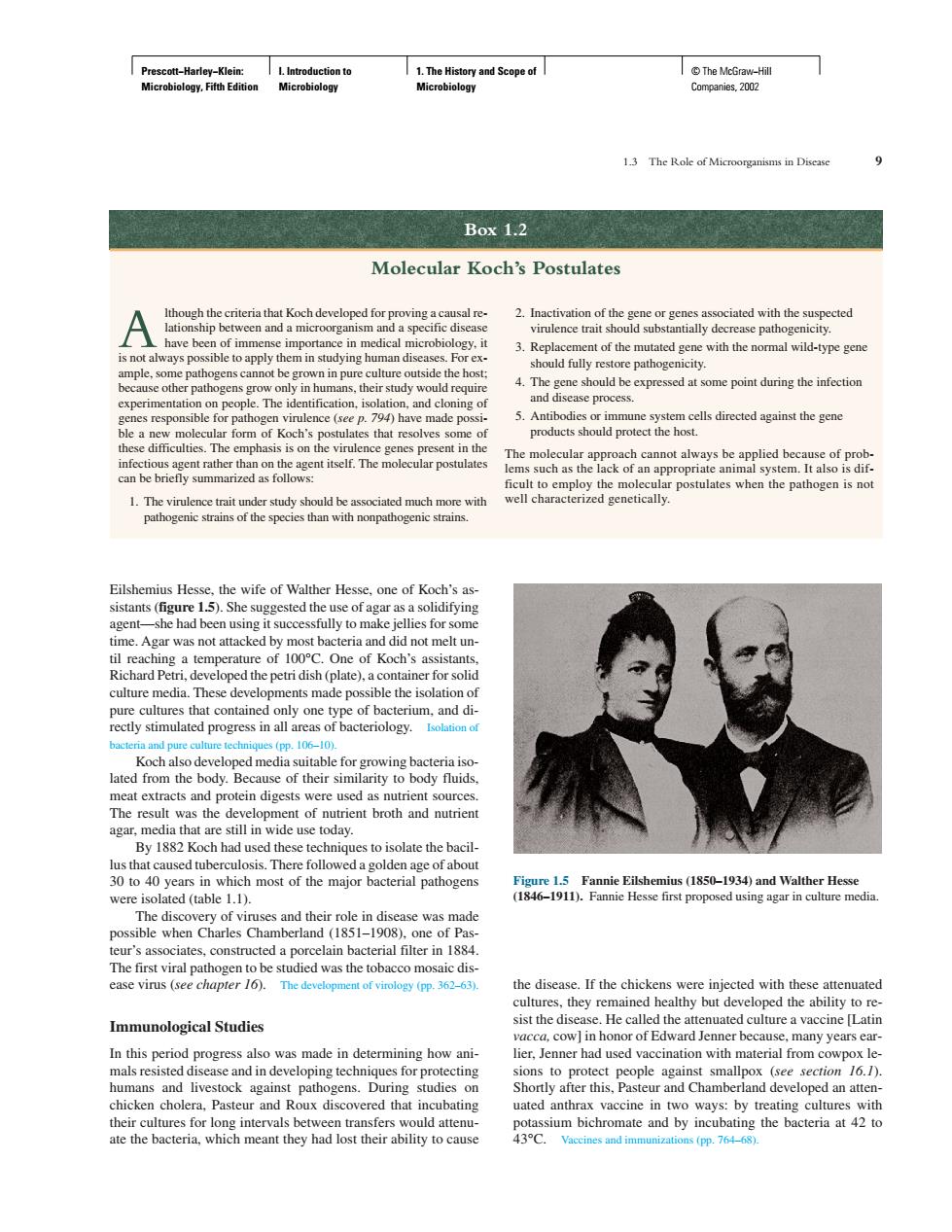正在加载图片...

Box 1.2 Molecular Koch's Postulates A 2.Inactiva einmeticdlmicrobiology. 3 Re t of the mutated gen i-ypegen Theebe pred at some pont dring the infection The i 1.The be iated much m with ne of Koch's 4。 e had sstully to mak es tor cctlymulated prood By 18 Koch had used these techniques to isolate the bacil 's associates,constructed a porcelain bacterialfilter in 188 the disease.If the chickens were iniected with these attenuated culures.they remained healthy but developed the ability tore Immunological Studies studies on ux discover that i uated anth x vaccine in【 C. s.764-68Prescott−Harley−Klein: Microbiology, Fifth Edition I. Introduction to Microbiology 1. The History and Scope of Microbiology © The McGraw−Hill Companies, 2002 Eilshemius Hesse, the wife of Walther Hesse, one of Koch’s assistants (figure 1.5). She suggested the use of agar as a solidifying agent—she had been using it successfully to make jellies for some time. Agar was not attacked by most bacteria and did not melt until reaching a temperature of 100°C. One of Koch’s assistants, Richard Petri, developed the petri dish (plate), a container for solid culture media. These developments made possible the isolation of pure cultures that contained only one type of bacterium, and directly stimulated progress in all areas of bacteriology. Isolation of bacteria and pure culture techniques (pp. 106–10). Koch also developed media suitable for growing bacteria isolated from the body. Because of their similarity to body fluids, meat extracts and protein digests were used as nutrient sources. The result was the development of nutrient broth and nutrient agar, media that are still in wide use today. By 1882 Koch had used these techniques to isolate the bacillus that caused tuberculosis. There followed a golden age of about 30 to 40 years in which most of the major bacterial pathogens were isolated (table 1.1). The discovery of viruses and their role in disease was made possible when Charles Chamberland (1851–1908), one of Pasteur’s associates, constructed a porcelain bacterial filter in 1884. The first viral pathogen to be studied was the tobacco mosaic disease virus (see chapter 16). The development of virology (pp. 362–63). Immunological Studies In this period progress also was made in determining how animals resisted disease and in developing techniques for protecting humans and livestock against pathogens. During studies on chicken cholera, Pasteur and Roux discovered that incubating their cultures for long intervals between transfers would attenuate the bacteria, which meant they had lost their ability to cause the disease. If the chickens were injected with these attenuated cultures, they remained healthy but developed the ability to resist the disease. He called the attenuated culture a vaccine [Latin vacca, cow] in honor of Edward Jenner because, many years earlier, Jenner had used vaccination with material from cowpox lesions to protect people against smallpox (see section 16.1). Shortly after this, Pasteur and Chamberland developed an attenuated anthrax vaccine in two ways: by treating cultures with potassium bichromate and by incubating the bacteria at 42 to 43°C. Vaccines and immunizations (pp. 764–68). 1.3 The Role of Microorganisms in Disease 9 Although the criteria that Koch developed for proving a causal relationship between and a microorganism and a specific disease have been of immense importance in medical microbiology, it is not always possible to apply them in studying human diseases. For example, some pathogens cannot be grown in pure culture outside the host; because other pathogens grow only in humans, their study would require experimentation on people. The identification, isolation, and cloning of genes responsible for pathogen virulence (see p. 794) have made possible a new molecular form of Koch’s postulates that resolves some of these difficulties. The emphasis is on the virulence genes present in the infectious agent rather than on the agent itself. The molecular postulates can be briefly summarized as follows: 1. The virulence trait under study should be associated much more with pathogenic strains of the species than with nonpathogenic strains. Box 1.2 Molecular Koch’s Postulates 2. Inactivation of the gene or genes associated with the suspected virulence trait should substantially decrease pathogenicity. 3. Replacement of the mutated gene with the normal wild-type gene should fully restore pathogenicity. 4. The gene should be expressed at some point during the infection and disease process. 5. Antibodies or immune system cells directed against the gene products should protect the host. The molecular approach cannot always be applied because of problems such as the lack of an appropriate animal system. It also is difficult to employ the molecular postulates when the pathogen is not well characterized genetically. Figure 1.5 Fannie Eilshemius (1850–1934) and Walther Hesse (1846–1911). Fannie Hesse first proposed using agar in culture media